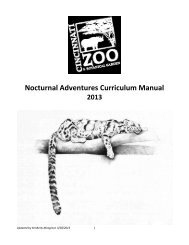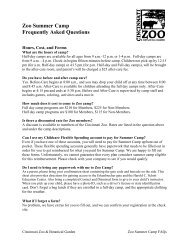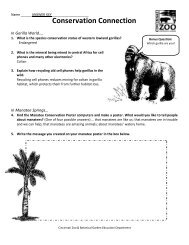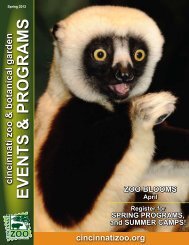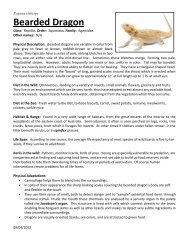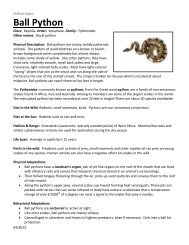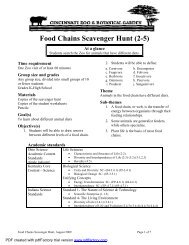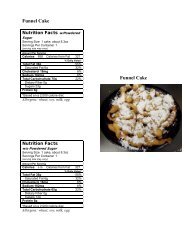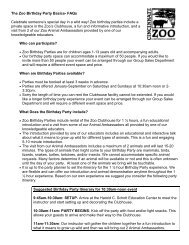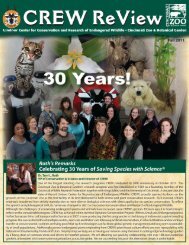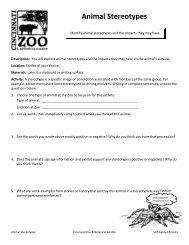Herring Gull - The Cincinnati Zoo & Botanical Garden
Herring Gull - The Cincinnati Zoo & Botanical Garden
Herring Gull - The Cincinnati Zoo & Botanical Garden
You also want an ePaper? Increase the reach of your titles
YUMPU automatically turns print PDFs into web optimized ePapers that Google loves.
Larus argentatus<strong>Herring</strong> <strong>Gull</strong>Class: Aves. Order: Chardiiformes . Family: Laridae.Other names: SeagullPhysical Description: <strong>The</strong> herring gull is a large common gullwith widespread distribution throughout the Northernhemisphere. As a result it can have many variations on its size,shape and plumage. <strong>The</strong>re is more about the bird’s plumageunder “Additional information” section.This species, like other large gulls, takes four years to obtain adult plumage, so young birds look quitedifferent from adults. Juveniles are brown while adults are white with light gray backs and wings. Adultshave black wing tips. <strong>The</strong> bill is yellow with a red spot on the lower mandible.<strong>The</strong>y are large gulls with an overall length of 25”, a wing spread of 4 ½ feet and weigh 2.5 pounds.Diet in the Wild: <strong>Herring</strong> gulls are omnivores, feeding on both plants and small animals such as fish,crustaceans and other animals. <strong>The</strong>y are highly adaptable and will adjust their diet to the type of habitatthey live in. Birds that live on rocky coasts prey on sea urchins, crabs, mussels and crayfish, on mudflatsthey hunt worms, clams and mussels while at sea the gulls follow fishing boats and catch small fish andother animals disturb by the boats wake. Newly plowed fields expose worms and other small invertebratesthat gulls may flock to. <strong>Herring</strong> gulls are also opportunistic scavengers and frequent dumps and recreationalareas to seek out scraps left behind. <strong>The</strong> opportunism of gulls extends to raiding nests of other seabirds,and one or two males per large breeding colony may even specialize in cannibalizing chicks of others in thecolony.Diet at the <strong>Zoo</strong>: Fish, bird of prey diet, insects.Range and Habitat:• <strong>Herring</strong> gulls are found around the world with several subspecies whose ranges include most ofNorth America, Siberia and Europe.• <strong>Herring</strong> <strong>Gull</strong>s' scavenging habits take them to open water, intertidal pools and shallows, mud flats,landfills, newly plowed fields, picnic grounds, and fish-processing plants. <strong>The</strong>y roost and loaf, oftenin large mixed species groups, in open areas with good visibility for spotting predators, includingagricultural and athletic fields, beaches, parking lots, airport runways, and garbage dumps. <strong>The</strong>ybreed near lakes in northern forests across Canada to Alaska and in some coastal areas.Life Span: Up to 15 years in captivityPerils in the wild: Birds of prey such as peregrine falcons are regular predators of many species of waterbirds including sandpipers, shorebirds, terns and gulls. Young chicks may be eaten by scavenging gulls in thecolony.07/2013
Physical Adaptations:• <strong>The</strong> wings of herring gulls are and amazing compromise of soaring, speed and agility, specializing inno one area but having the potential to be good at all. <strong>The</strong>ir fight style works well for the coastalhabitats it inhabits. Often circling over head and then diving quickly when food is spotted.• <strong>Herring</strong> gulls feet are webbed so they can swim while floating on the water surface, but not as agileas a diving duck or penguin.• <strong>The</strong>ir elongated beak is well adapted for• <strong>Herring</strong> <strong>Gull</strong>s prefer drinking freshwater, but they'll drink seawater when they must. Special glandslocated over the eyes allow them to excrete the salt that would otherwise dehydrate most animals,including us. <strong>The</strong> salty excretion can be seen dripping out of their nostrils and off the ends of theirbills.Behavioral Adaptations:• <strong>Herring</strong> <strong>Gull</strong>s patrol shorelines and open ocean in widely scattered groups, soaring raptor-like andspiraling down to pick scraps off the surface. Individuals plunge-dive from near the surface and dipwhile paddling to take shallow prey. Rallying around fishing boats or refuse dumps, they are raucousand competitive, threatening and stealing from other birds. <strong>The</strong>y'll prowl tide flats seeking outinvertebrates, gobbling small items whole, picking apart larger prey, and dropping shellfish ontorocks to break them open. Tighter groups follow foraging whales, groups of dolphins, or schools oflarge fish in open water, hovering to nab small prey driven to the surface.• <strong>Herring</strong> gulls live in colonies and can be seen flying in groups looking for food, “loafing” whilewaiting for feeding opportunities. Loafing is a term used to describe the leisure period of nappingand not doing much of anything! Opportunistic feeders such as gulls and birds of prey may spend aconsiderable amount of time loafing.• Young <strong>Herring</strong> <strong>Gull</strong>s appear to be more migratory than adults. In some areas, such as the GreatLakes, most adults remain near their breeding grounds, but the non-breeders move father south inthe fall.• Even though they live in flocks or colonies, herring gulls mate for life and will return to the samenest sites or area each year.Reproduction and Development:• <strong>Herring</strong> <strong>Gull</strong> pairs pick nesting sites together in the soft soil, sand, or short vegetation of theirterritory. To protect the nest from prevailing winds and hide it from predators, it is usually placednext to a rock, log, or bush. This also hides it from the nearest neighbors. Crevices may be used asnest sites in rocky areas.• Several days before egg-laying, pairs hollow out up to four depressions 10–15 inches across withcentral depressions 4–8 inches wide and about the depth of an egg. <strong>The</strong>y line the scrapes withvegetation, feathers, plastic, rope, or other materials. <strong>The</strong> pair chooses the final nest from thesealternates. After the female lays her eggs, the pair continues to add vegetation to this nestthroughout the month long incubation. Sand nests are sometimes left unlined or only sparsely lined.• <strong>The</strong>y lay 1-3 eggs that are about 3” long and 2” wide. Incubation is 31 days until hatching.• <strong>The</strong> young are cared for in the nest for about 45-50 days. <strong>The</strong>y are demanding feeders and canconsume as much as a half a pound of food daily when they are large. This requires both parents toforage for food 24 hours a day to provide enough food for the young and themselves.07/2013
• Sibling rivalry is a problem in the bird world, too. <strong>The</strong> third chick in a herring gull clutch can have itespecially tough. While the first two chicks hatch the same day, the third is born a day or two later,weighs less, gets less food, and grows more slowly.Additional Information:• Variety of plumages: <strong>Herring</strong> gulls display many variations in plumage over a life time. <strong>The</strong> birdshave a long period of immaturity where they go through successive molts until they reach maturityat about four years old. As adults the birds display a breeding and non-breeding plumage as shownbelow.Immature herring gullAdult herring gull in spring plumage<strong>The</strong> herring gull’s plumage changes over several years from a brown marked immature to a white and greyadult.07/2013Adult herring gull in winter plumageConservation Status: (IUCN Status)L/C Least Concern, population increasing; IUCN 2013Conservation Efforts:• <strong>Herring</strong> gulls benefit from protection of wetland habitat that is home to a tremendous diversity ofwildlife.
Glossary: List of definitions of the most important recurrent technical terms used in the text.Aves- <strong>The</strong> class of vertebrates that is represented by the birds. Approximately 9000-10,000 speciesidentified.Chardiiformes- <strong>The</strong> order of birds that includes shorebirds, gulls, terns, skuas and auks.Laridae- <strong>The</strong> family of gulls and terns.Plumage- <strong>The</strong> feathers that cover a birds body parts. Feather types include contour, down, flight, sensoryand display feathers. In many species the external characteristics of feathers such as color or externaldisplays, may help to identify the species, sex or age of the individual bird.Omnivore- And organism that feeds on both plants and animals,Sources:• <strong>Cincinnati</strong> <strong>Zoo</strong> & <strong>Botanical</strong> <strong>Garden</strong>s• Sibley, D.A. 2000. <strong>The</strong> Sibley Guide to Birds• http://www.allaboutbirds.org/guide/herring_gull/lifehistory• Hickman, C.P. Roberts, L.S. 1994. Biology of Animals07/2013




